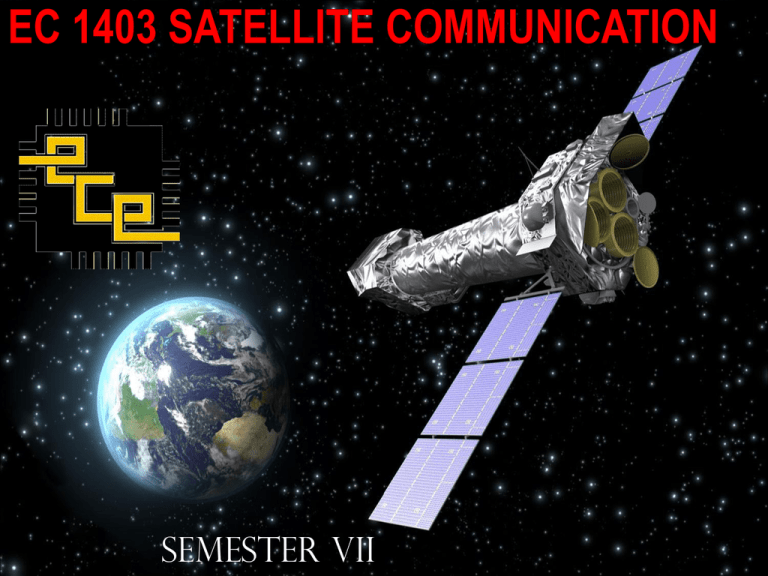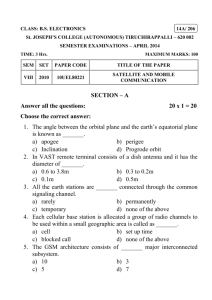EC 1403 SATELLITE COMMUNICATION
advertisement

EC 1403 SATELLITE COMMUNICATION SEMESTER VII Overview of satellite systems, orbits and launching methods • Introduction – Frequency allocations for satellite services – Intelsat – U.S domsats – Polar orbiting satellites – Problems – Kepler’s first law – Kepler’s second law – Kepler’s third law – Definitions of terms for earth – Orbiting satellites – Orbital elements – Apogee and perigee heights – Orbital perturbations – Effects of a non-spherical earth – Atmospheric drag – Inclined orbits – Calendars – Universal time – Julian dates – Sidereal time – The orbital plane – The geocentric – Equatorial coordinate system – Earth station referred to the IJK frame – The topcentric – Horizon coordinate system – The subsatellite point – Predicting satellite position. Geostationary Orbit And Space Segment • Introduction – Antenna look angles – The polar mount antenna – Limits of visibility – Near geostationary orbits – Earth eclipse of satellite – Sun transit outage – Launching orbits – Problems – Power supply – Attitude control – Spinning satellite stabilization – Momentum wheel stabilization – Station keeping – Thermal control – TT&C subsystem – Transponders – Wide band receiver – Input demultiplexer – Power amplifier – Antenna subsystem – Morelos-anik – E-advanced tiros – N spacecraft Earth Segment And Space Link • Introduction – Receive – Only home TV systems – Outdoor unit – Indoor unit for analog (FM) TV – Master antenna TV system – Community antenna TV system – Transmit – Receive earth stations – Problems – Equivalent isotropic radiated power – Transmission losses – Free-space transmission – Feeder losses – Antenna misalignment losses – Fixed atmospheric and ionospheric losses – Link power budget equation – System noise – Antenna noise – Amplifier noise temperature – Amplifiers in cascade – Noise factor – Noise temperature of absorptive networks – Overall system noise temperature – Carrier to- Noise ratio – Uplink – Saturation flux density – Input back off – The earth station HPA – Downlink – Output back off – Satellite TWTA output – Effects of rain – Uplink rain– Fade margin – Downlink rain – Fade margin – Combined uplink and downlink C/N ratio – Inter modulation noise. UNIT IV Satellite Access • Single access – Preassigned FDMA, Demand assigned FDMA, SPADE system.bandwidth – Limited power – Limited TWT amplifier operation, FDMA downlink analysis. • TDMA: Reference burst – Preamble and post amble – Carrier recovery – Network synchronization – Unique word detection – Traffic date – Frame efficiency and channel capacity – Preassigned TDMA – Demand assigned TDMA – Speech interpolation and prediction – Downlink analysis for digital transmission – Calculation of uplink power requirements for FDMA and TDMA – On-board signal processing for TDMA / FDMA operation – Satellite switched TDMA • Code Division Multiple Access – Direct sequence spread spectrum – Code Signal C(T) – Autocorrelation function for C(T) – Acquisition and tracking – Spectrum spreading and despreading – CDMA throughput – Problems – Network layers – TCP link – Satellite links and TCP – Enhancing TCP over satellite channels using standard mechanisms (RFC– 2488) – Requests for comments – Split TCP connections – Asymmetric channels – Proposed systems – Direct broadcast satellite services. Geographic Information System • GIS – Components of GIS – Hardware, software and organisational context – Data – Spatial and Non-spatial – Maps – Types of maps –Visual interpretation of satellite images – Elements of interpretation – Interpretation keys characteristics of digital satellite image – Image enhancement – Filtering – Classification – Integration of GIS and remote sensing – Urban applications – Application of remote sensing and GIS – Water resources – Urban analysis – Watershed management – Resources information systems. Global Positioning System (GPS) – An introduction. Image Filtering TEXT BOOKS • Dennis Roddy, “Satellite Communications”, 3rd Edition, TMH Publication, 2001 • Anji Reddy, “Remote Sensing and Geographical Information Systems”, BS Publications, 2001. ASSIGNMENTS • • • • • • • KEPLER’S LAWS CO-ORDINATE SYSTEMS TRANSPONDERS TRANSMISSION LOSSES TDMA FDMA GPS SEMINAR TOPICS • • • • • GEOSTATIONARY SATELLITES DTH REMOTE SENSING GIS GPS URL’S • http://www.odyseus.nildram.co.uk/Systems_And_Devices_Files/Sat_Comms.pdf • http://www.aticourses.com/iridium.htm • http://www.aticourses.com/global_positioning_system.htm • http://www.palowireless.com/satellite/tutorials.asp • http://www.gatewayforindia.com/technology/satellite.htm • http://www.crisp.nus.edu.sg/~research/tutorial/intro.htm • http://www.radio-electronics.com/info/satellite/communications_satellite/satellitecommunications-basics-tutorial.php






